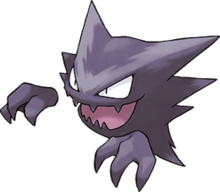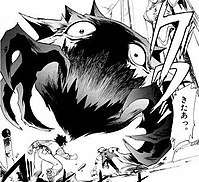Haunter
Haunter, known in Japan as Ghost (ゴースト, Gōsuto), is a Pokémon species in Nintendo and Game Freak's Pokémon franchise. Designed by Game Freak and originally intended to be renamed Spectre for North American audiences, their name is a derivative of the verb "to haunt", and is both the singular and plural name of the species. First appearing in Pokémon Red and Blue, they later appeared in subsequent sequels, spin-off titles such as Pokémon Snap, merchandise related to the series, and both animated and printed adaptations of the franchise. It is known as the Gas Pokémon. In animated appearances, Haunter are voiced in Japanese by Toshiyuki Morikawa and in English localizations by Ted Lewis.
| Haunter | |
|---|---|
| Pokémon series character | |
 | |
| First game | Pokémon Red and Blue |
| Designed by | Ken Sugimori |
| Voiced by | Ted Lewis (English) Toshiyuki Morikawa (Japanese) |
Haunter has been well received by the media, with groups such as IGN and GamesRadar praising its abilities and style, the former of which described it as superior to its stronger counterpart, Gengar. Its characterization within the game's setting has similarly met praise and been described as one of the more vivid aspects of the series, though at the same time the same characterization has drawn fire from several fundamentalist Christian groups in various books.
Conception and design
Developed by Game Freak and published by Nintendo, the Pokémon series began in Japan in 1996, and features several species of creatures called "Pokémon" that players, called "trainers", are encouraged to capture, train, and use to battle other players' Pokémon or interact with the game's world.[1][2] Haunter was one of several different Pokémon designs conceived by Game Freak's character development team and finalized by artist Ken Sugimori.[3][4] Called "Ghost" in Japanese, Nintendo decided to give the various Pokémon species "clever and descriptive names" related to their appearance or features when translating the game for western audiences as a means to make the characters more relatable to American children.[5] Called "Spectre" in early drafts of the localization, the final version dubbed the species "Haunter", derived from the verb "to haunt".[6]
Called the "Gas Pokémon", Haunter appears as a purple, levitating triangular creature, with three spikes extending from each side of its head, angled towards its backside and slightly upward. Its lower back ends in a larger cone-shaped tail, ending in a jagged edge on the sides and of nearly equal length of its body. Its face consists of two white triangular eyes and a wide, pink mouth with jagged teeth that blend into its body. Haunter's body levitates in the air while its sole appendages—two disembodied three-finger hands—hover in the air in front of it. Within the lore of the series, Haunter are described as hiding in very dark places such as graveyards and abandoned caves, stalking their prey.[7] Despite its appearance and nature, Haunter is seen as a serious physical threat to trainers and their Pokémon, who are strongly advised to flee if sighted by one. Haunter is known to gesture unsuspecting trainers and Pokémon before licking them with their large tongue; the attack suppresses motor functions, drastically drains the victim's life energy, causes paralysis and rapid shaking, and the victim's death (possibly a reference to nerve agents)[8] Haunter can also turn intangible to pass through solid objects, or camouflage themselves as a floating purple orb.[9] A Gastly can transform, or "evolve", into Haunter, while Haunter in turn can evolve into a Gengar. In the context of the games, this requires leveling up a Gastly to level twenty-five, and trading a Haunter to another player respectively.
Appearances

Haunter was introduced in Pokémon Red and Blue, where it appears in the Pokémon Tower, a memorial for dead Pokémon, once the player has obtained the "Silph Scope" item.[10] It later appeared in all subsequent sequels, able to be captured in all except Pokémon Ruby and Sapphire and Pokémon Black and White. Within these games, Haunter also appears as a Pokémon used by enemy NPC trainers, such as "channeler" enemies in the Pokémon Tower or Ecruteak City Gym Leader Morty in Pokémon Gold and Silver. The character has also appeared in related spinoff titles, including Pokémon Snap, the Pokémon Mystery Dungeon games, the Pokémon Ranger games, and PokéPark Wii: Pikachu's Adventure.
In the anime, Haunter first appeared in The Tower of Terror, where protagonist Ash befriended it, and it followed him to Saffron City to battle gym leader Sabrina.[11] Instead of fighting however, it first fled, and during a rematch resorted to making faces and other antics in front of Sabrina, including blowing itself up with a harmless bomb. The result sends her into a laughing fit, disabling her Pokémon and letting Ash win by default. Afterward, it chooses to remain with her as Ash carries on his way.[12] Morty used a Haunter to battle Ash in From Ghost to Ghost.[13] In Fear Factor Phony, a Haunter was living in an abandoned mine with several other Ghost Pokémon. The Ghost Pokémon were having difficulty with the partying Psychic Pokémon living nearby.[14]
In the Pokémon Adventures manga, Agatha used a single Haunter as a part of her team, and used a swarm of Haunter in her attack on Kanto. Eusine was later seen with a Haunter in Volume 14. A gigantic Haunter called "The Black Fog" was featured in the fourth chapter of The Electric Tale of Pikachu, using its abilities to steal the souls of humans and Pokémon alike. Though Ash attempted to capture it, the Black Fog instead self-destructed. It was later revealed the Black Fog had once become accustomed to being worshiped as a god, and chose to die instead of being captured by a human.[15]
Promotion and reception
Since it appeared in Pokémon Red and Blue, Haunter has appeared on several pieces of merchandise, including figurines and cards for the Pokémon Trading Card Game.
GamesRadar described Haunter alongside Gastly and Gengar as "highly useful",[16] further describing its abilities and design as "top shelf".[17] They later called it one of the series' "quintessential Ghost-type Pokemon", though expressed surprise for its popularity in light of an existing glitch in Pokémon Red and Blue that hampered its fighting abilities.[18] In a podcast, they named it as one of their favorite ghost-type Pokémon from the series, attributing its popularity to both its design and its presence in the anime which they felt gave it character as both "funny" and with a "big tongue".[19] It was also named by them as one of the series' most disturbing characters, calling it an "already badass looking Pokemon" and described its ability to "[cripple] its victims with fatal convulsions" as "a whole new realm of fear".[20] Game Informer editor Tim Turi listed Haunter among the top 10 ghosts, saying the "spooky, toxic mess" is a design "straight out of left field", calling it "brutal for such a cute little guy".[21]
IGN contributor "PokemonofthedayChick" stated that despite Gengar's higher statistics, "Haunter always has been and always will be cooler", further describing it as having "built quite a loyal following for itself over the years".[22] IGN editor Jack DeVries later agreed with the statement, adding "the real Ghost Type Pokémon that sticks out in gamer memory is Haunter".[23] Official Nintendo Magazine described it as one of the top ten ghosts within Nintendo games, stating that its appearance made it look "every bit as fearsome" as its evolution Gengar and adding that its described behavior made it "even more creepy".[24] Generazione Pókemon described Haunter's traits as one of the more vivid aspects of the games, citing specifically its ability to devour energy from its opponents.[25] Fundamentalist Christian groups however have been critical of the character, calling it "demonic" and critical of the implications of its character design, primarily its existence as a "ghost" within the game's setting.[26][27][28]
References
- Game Freak (1998-09-30). Pokémon Red and Blue, Instruction manual. Nintendo. pp. 6–7.
- Game Freak (1998-09-30). Pokémon Red and Blue, Instruction manual. Nintendo. p. 11.
- Staff. "2. 一新されたポケモンの世界". Nintendo.com (in Japanese). Nintendo. p. 2. Retrieved 2010-09-10.
- Stuart Bishop (2003-05-30). "Game Freak on Pokémon!". CVG. Archived from the original on 2008-02-08. Retrieved 2008-02-07.
- Chua-Euan, Howard (November 22, 1999). "PokéMania". TIME. Retrieved 2008-09-15.
- Staff. "#093 Haunter". IGN. IGN Entertainment. Retrieved 2009-10-04.
- Game Freak (2001-07-29). Pokémon Crystal (Game Boy Color). Nintendo.
It hides in the dark, planning to take the life of the next living thing that wanders close by.
- Game Freak (1999-10-19). Pokémon Yellow (Game Boy). Nintendo.
By licking, it saps the victim's life. It causes shaking that won't stop until the victim's demise.
- Game Freak (1998-09-30). Pokémon Red (Game Boy). Nintendo.
Because of its ability to slip through block walls, it is said to be from another dimension.
- Game Freak (1998-09-30). Pokémon Red (Game Boy). Nintendo.
- Hideki Sonoda (writer) (October 7, 1998). "The Tower of Terror". Pokémon. Season Indigo League. Episode 23. Various.
- Junki Takegami (writer) (October 8, 1998). "Haunter versus Kadabra". Pokémon. Season Indigo League. Episode 24. Various.
- Atsuhiro Tomioka (writer) (November 10, 2001). "From Ghost to Ghost". Pokémon. Season Johto League Champions. Episode 182. Various.
- Junki Takegami (writer) (September 8, 2006). "Fear Factor Phony". Pokémon. Season Battle Frontier. Episode AG146. Various.
- Toshihiro Ono (w). "Haunting My Dreams" The Electric Tale of Pikachu 4 (1997-10-28), Japan: Shogakukan, 4-09-149341-6
- Elston, Brett. "The complete Pokemon RBY pokedex, part 9". GamesRadar. Future Publishing. p. 4. Retrieved 2009-10-03.
- Elston, Brett. "The complete Pokemon RBY pokedex, part 9". GamesRadar. Future Publishing. p. 5. Retrieved 2009-10-03.
- Gudmundson, Carolyn (2010-10-29). "A tribute to Ghost-type Pokemon". GamesRadar. Future Publishing. Archived from the original on 2011-06-15. Retrieved 2010-10-30.
- Gudmundson, Carolyn (2010-11-01). "Pokemon Monday 24 - AH-knee-meh". GamesRadar (Podcast). Future Publishing. Retrieved 2010-11-02.
- Elston, Brett. "The most disturbing Pokémon of all time". GamesRadar. Future Publishing. p. 2. Retrieved 2015-04-30.
- Tim Turi (October 2013). "Game Informer". 246. GameStop: 26. Cite journal requires
|journal=(help) - Staff (2002-10-28). "Pokémon of the Day: #093 Haunter". IGN. IGN Entertainment. Retrieved 2009-10-14.
- DeVries, Jack (2011-04-27). "Haunter". IGN. IGN Entertainment. Retrieved 2011-04-28.
- Tom East (31 Oct 2009). "Nintendo Feature: Best Nintendo Ghosts: Your Say - Official Nintendo Magazine". Official Nintendo Magazine. Archived from the original on 17 May 2013. Retrieved 2010-09-23.
- Lipperini, Loredana (2000). Generazione Pókemon: I Bambini e L'invasione Planetaria Dei Nuovi 'Giocattoli di Ruolo' (in Italian). Castelvecchi. pp. 146, 230. ISBN 88-8210-249-1.
- Arms, Phil (2000). Pokemon & Harry Potter: A Betrayal of Trust. Hearthstone Publishing, Limited. ISBN 1-57558-067-5.
- "Spiritual Counterfeits Project Journal". 23 (3). Spiritual Counterfeits Project. 2000: 34, 40. Cite journal requires
|journal=(help) - "Charisma and Christian Life". 25 (6–11). Strang Communications Co. 2000: 60–62. Cite journal requires
|journal=(help)